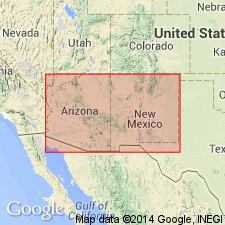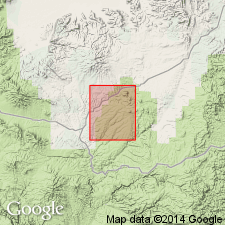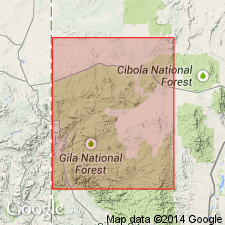
- Usage in publication:
-
- Railroad Canyon Rhyolite
- Modifications:
-
- Paleomagnetics
- AAPG geologic province:
-
- Basin-and-Range province
Summary:
In a section measured in Reserve area, southeast of San Francisco Mountains, Catron Co, NM, Basin-and-Range province, Railroad Canyon Rhyolite is found to be reversely magnetized. Magnetostratigraphic position of Railroad Canyon unit within a preliminary model of the middle Tertiary paleomagnetic reversal pattern is depicted on figs. 4 and 5.
Source: GNU records (USGS DDS-6; Denver GNULEX).

- Usage in publication:
-
- Railroad Canyon Rhyolite†
- Modifications:
-
- Abandoned
Summary:
Abandoned because detailed mapping, new age dates, and minor-element chemistry indicate that parts of the Railroad Canyon Tuff are distal remnants of Oligocene Bloodgood Canyon Tuff (Ratte and others, 1984). Other parts of Railroad Canyon Tuff, as mapped by Fodor (1976) in Indian Peaks area, consist chiefly of locally derived tuff of Garcia Camp, lithic-rich ash-flow tuffs, and a rhyodacite ash-flow tuff of probable regional extent. Constituent tuffs all separately mapped in Indian Peaks West quad.
Source: GNU records (USGS DDS-6; Denver GNULEX).

- Usage in publication:
-
- Railroad Canyon Rhyolite
- Modifications:
-
- Not used
Summary:
Consists in the Indian Peak area, Black Range, Grant and Catron Cos, NM, Basin-and-Range province, of two regional tuffs, now recognized as Bloodgood Canyon Tuff and Shelley Peak Tuff, and two local pyroclastic flow deposits, the tuff of Garcia Camp, and several local lithic- and pumice-rich tuffs which are interbedded with dome-flow rhyolites. Overlies Taylor Creek Rhyolite. Is not a valid name.
Source: GNU records (USGS DDS-6; Denver GNULEX).
For more information, please contact Nancy Stamm, Geologic Names Committee Secretary.
Asterisk (*) indicates published by U.S. Geological Survey authors.
"No current usage" (†) implies that a name has been abandoned or has fallen into disuse. Former usage and, if known, replacement name given in parentheses ( ).
Slash (/) indicates name conflicts with nomenclatural guidelines (CSN, 1933; ACSN, 1961, 1970; NACSN, 1983, 2005, 2021). May be explained within brackets ([ ]).

